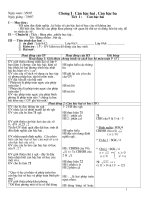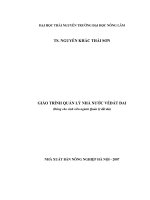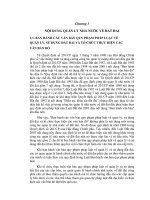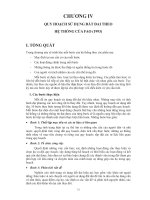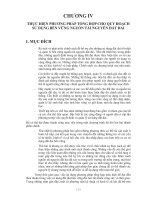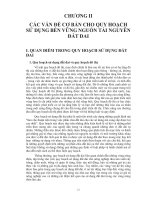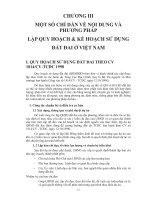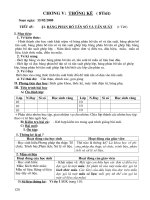Đại chương về lãnh đạo trong tổ chức chapter 1 who is a leader cuuduongthancong com
Bạn đang xem bản rút gọn của tài liệu. Xem và tải ngay bản đầy đủ của tài liệu tại đây (8.9 MB, 30 trang )
LEADERSHIP:
ng
2d Edition
.c
om
Theory, Application, Skill Development
.
ng
th
an
co
Robert N. Lussier
and Christopher F. Achua
du
o
This presentation edited and enhanced by:
George W. Crawford
cu
u
Asst. Prof. of Mgmt.
Clayton College & State University
Morrow, GA 30260
Copyright ©2004 by South-Western, division of Thomson Learning. All rights reserved.
CuuDuongThanCong.com
1-1
/>
.c
om
th
an
co
ng
Chapter 1
cu
u
du
o
ng
Who Is A
Leader?
1-2
Copyright ©2004 by South-Western, a division of Thomson Learning. All rights reserved.
CuuDuongThanCong.com
/>
.c
om
Chapter 1
Learning Outcomes
cu
u
du
o
ng
th
an
co
ng
• 5 key elements of leadership
• 10 managerial roles
• Levels of leadership analysis
interrelationship
• Behavioral leadership theories
• Trait & behavioral leadership
theories and contingency theories
1-3
Copyright ©2004 by South-Western, a division of Thomson Learning. All rights reserved.
CuuDuongThanCong.com
/>
.c
om
Why Leadership
is Important
cu
u
du
o
ng
th
an
co
ng
• For crisis situations
• For organizational
performance
• For employee job
satisfaction
ã For successful management
1-4
Copyright â2004 by South-Western, a division of Thomson Learning. All rights reserved.
CuuDuongThanCong.com
/>
cu
u
du
o
ng
th
an
co
ng
.c
om
Leadership is the
influencing process
of leaders and
followers to achieve
organizational
objectives through
change
1-5
Copyright ©2004 by South-Western, a division of Thomson Learning. All rights reserved.
CuuDuongThanCong.com
/>
Influence
cu
u
du
o
ng
th
an
co
ng
.c
om
• Is the process of a leader
communicating ideas, gaining
acceptance of them, and
motivating followers to
support and implement the
ideas through change
• Is the essence of leadership
1-6
Copyright ©2004 by South-Western, a division of Thomson Learning. All rights reserved.
CuuDuongThanCong.com
/>
.c
om
Effective Leaders
cu
u
du
o
ng
th
an
co
ng
• Share leadership
responsibilities through coleadership
• Teach leadership skills to
subordinates
• Influence followers to
support organizational
interests
1-7
Copyright ©2004 by South-Western, a division of Thomson Learning. All rights reserved.
CuuDuongThanCong.com
/>
.c
om
Effective Leaders
cu
u
du
o
ng
th
an
co
ng
• Set objectives
• Influence change for
continual improvement
• Can work with people
1-8
Copyright ©2004 by South-Western, a division of Thomson Learning. All rights reserved.
CuuDuongThanCong.com
/>
ng
.c
om
Key Elements of
Leadership
du
o
Leadership
Organizational
Objectives
cu
u
LeadersFollowers
ng
th
an
co
Influence
Change
People
1-9
Copyright ©2004 by South-Western, a division of Thomson Learning. All rights reserved.
CuuDuongThanCong.com
/>
Managerial Roles
.c
om
1. Figurehead
2. Leader
3. Liaison
u
du
o
th
ng
Informational
an
co
ng
Interpersonal
cu
Decisional
4. Monitor
5. Disseminator
6. Spokesperson
7. Entrepreneur
8. Disturbance-handler
9. Resource-allocator
10. Negotiator
1-10
Copyright ©2004 by South-Western, a division of Thomson Learning. All rights reserved.
CuuDuongThanCong.com
/>
cu
u
du
o
ng
th
an
co
ng
.c
om
3 Levels of
Leadership Analysis
Individual
1-11
Copyright ©2004 by South-Western, a division of Thomson Learning. All rights reserved.
CuuDuongThanCong.com
/>
.c
om
Individual Level
cu
u
du
o
ng
th
an
co
ng
• Focuses on the individual
leader and the relationship
with individual followers
ã Called the dyadic process
ã Reciprocal Influence
1-12
Copyright â2004 by South-Western, a division of Thomson Learning. All rights reserved.
CuuDuongThanCong.com
/>
.c
om
Group Level
cu
u
du
o
ng
th
an
co
ng
• Focuses on the individual
leader and the collective
group of followers
• Called the “group process”
• How leader contributes to
group effectiveness
1-13
Copyright ©2004 by South-Western, a division of Thomson Learning. All rights reserved.
CuuDuongThanCong.com
/>
.c
om
Organizational Level
cu
u
du
o
ng
th
an
co
ng
• Focuses on how the top
management influences
organizational performance
• Called the “organizational
process”
1-14
Copyright ©2004 by South-Western, a division of Thomson Learning. All rights reserved.
CuuDuongThanCong.com
/>
Contingency
cu
u
Trait
du
o
ng
th
an
co
ng
.c
om
The 4 Leadership
Theory
Classifications
Include:
Behavioral
Integrative
1-15
Copyright ©2004 by South-Western, a division of Thomson Learning. All rights reserved.
CuuDuongThanCong.com
/>
Leadership Trait
Theories
cu
u
du
o
ng
th
an
co
ng
.c
om
Attempt to explain
distinctive
characteristics
accounting for
leadership
effectiveness to
identify a set of traits
that all successful
leaders possess
1-16
Copyright ©2004 by South-Western, a division of Thomson Learning. All rights reserved.
CuuDuongThanCong.com
/>
cu
u
du
o
ng
th
an
co
ng
Attempt to explain
distinctive styles used
by effective leaders,
or to define the
nature of their work
.c
om
Behavioral Leadership
Theories
1-17
Copyright ©2004 by South-Western, a division of Thomson Learning. All rights reserved.
CuuDuongThanCong.com
/>
Contingency Leadership
Theories
cu
u
du
o
ng
th
an
co
ng
.c
om
Attempt to
explain the
appropriate
leadership style
based on the
leader,
followers,
and situation
1-18
Copyright ©2004 by South-Western, a division of Thomson Learning. All rights reserved.
CuuDuongThanCong.com
/>
.c
om
Integrative Leadership
Theories
cu
u
du
o
ng
th
an
co
ng
Attempt to combine
the trait, behavioral,
and contingency
theories to explain
successful, influencing
leader-follower
relationships
1-19
Copyright ©2004 by South-Western, a division of Thomson Learning. All rights reserved.
CuuDuongThanCong.com
/>
cu
u
du
o
ng
th
an
co
ng
.c
om
Paradigm Has
Shifted From
Management to
Leadership!
1-20
Copyright ©2004 by South-Western, a division of Thomson Learning. All rights reserved.
CuuDuongThanCong.com
/>
Leaders vs. Managers
u
du
o
ng
•
•
•
•
•
•
•
Innovate
Develop
Inspire
Long-term view
Ask “what & why”
Originate
Challenge status
quo
• Do the right
things
1-21
ng
co
an
th
Administer
Maintain
Control
Short-term view
Ask how & when
Imitate
Accept status quo
Do things right
cu
ã
ã
ã
ã
ã
ã
ã
ã
Leaders
.c
om
Managers
Copyright â2004 by South-Western, a division of Thomson Learning. All rights reserved.
CuuDuongThanCong.com
/>
.c
om
Discussion Question #1
cu
u
du
o
ng
th
an
co
ng
What is the difference
between peer-leadership
and coleadership?
Copyright ©2004 by South-Western, a division of Thomson Learning. All rights reserved.
CuuDuongThanCong.com
/>
.c
om
Discussion Question #2
cu
u
du
o
ng
th
an
co
ng
Do you agree that, in
general, mean or tough
bosses are not successful
leaders?
Copyright ©2004 by South-Western, a division of Thomson Learning. All rights reserved.
CuuDuongThanCong.com
/>
.c
om
Discussion Question #3
cu
u
du
o
ng
th
an
co
ng
Are leaders born
or made?
Copyright ©2004 by South-Western, a division of Thomson Learning. All rights reserved.
CuuDuongThanCong.com
/>
.c
om
Discussion Question #4
cu
u
du
o
ng
th
an
co
ng
Why does the
leadership role pervade
all management
behavior?
Copyright ©2004 by South-Western, a division of Thomson Learning. All rights reserved.
CuuDuongThanCong.com
/>
